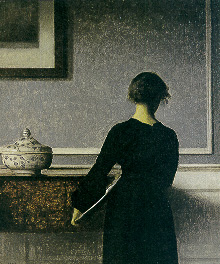 Vilhelm Hammershøi Interior[with young woman seen from behind, Strandgade 30], ca. 1903-1904 Oil on canvas Randers Kunstmuseum, Randers, Denmark |
VILHELM HAMMERSHØI (1864 - 1916): Danish Painter of Solitude and Light |
|
The major sponsor of this exhibition is Novo Nordisk Vilhelm Hammershøi was born in 1864, one year after Edvard Munch, his better-known Norwegian contemporary. Although he established a name throughout Europe during his lifetime, Hammershøi's international reputation waned after his death in 1916 at the age of 51. This retrospective of his work, seen first in Copenhagen and Paris last year, created a sensation, with Hammershøi hailed as "the Danish Vermeer." This rediscovery of his work outside Denmark was declared by art critics to be comparable in importance to the rediscovery of both Vermeer and Georges de la Tour. Exhibition co-curator Robert Rosenblum, Curator of Twentieth-Century Art at the Solomon R. Guggenheim Museum and Professor of Fine Arts, New York University, stated, Hammershøi's minimal interiors hover between melancholy domestic prisons and immaculate geometric abstractions. His revival not only marks our growing fascination with the diversity of national traditions in European art, but brings us a painter of unforgettably haunting power. Hammershøi painted in a realistic style, with a limited palette of muted colors, predominantly on a gray scale. Like Vermeer, he is known for his views of contemporary interiors. Many of Hammershøi's paintings represent sparsely furnished rooms in the artist's own home in Copenhagen, an historic seventeenth-century house. Often completely empty of people, the images are steeped in a mood of melancholy, isolation, and loss. In some of the paintings, a lone figure, usually a woman, is seen from behind. Light is a principal element in almost all of Hammershøi's paintings, and is instrumental in evoking not only architectural space but also an emotional response in the viewer. In addition to interiors, Hammershøi also painted landscapes of unusual barrenness, as well as some highly original portraits and nudes. Included in the exhibition are a number of psychologically penetrating portraits of the artist's wife, Ida, as well as works that reference ancient mythology. Hammershøi began his training as an artist at the age of eight, and entered the Royal Academy of Art in Copenhagen at 15. During the final two years of his five-year course of study, he concurrently attended De Frie Studieskoler, the more progressive alternative to the conservative Academy. Hammershøi made his official debut as an artist at the age of 21 with a portrait of his sister painted in 1885, entitled Portrait of a Young Girl [Anna Hammershøi]. The painting demonstrated an original vision and disregard for accepted conventions of naturalism, and its public exhibition instantly made Hammershøi a figure of controversy in the Danish art world. In his work, Hammershøi drew on the tradition of the Danish Golden Age painters, who between the years of 1820 to 1850 created a specifically Danish art that celebrated the beauty of everyday life. Hammershøi's vision was much more bleak than that of his predecessors, however, and he was fascinated with the use of grisaille, a technique employed by several leading artists of the time, including Whistler, whom he greatly admired. In 1887, Hammershøi made a trip to Holland to study Dutch seventeenth-century painting, which had a strong effect on his development. His debt to Dutch masters such as Vermeer and De Hooch can be seen in his subsequent work. Hammershøi traveled extensively in Europe,
including sojourns in Belgium, Germany, Italy, France,
and England. He exhibited his work in the 1889
Worldâs Fair in Paris, as well as in other
European venues. Paradoxically, Hammershøi
retained an artistic identity that was seen as
distinctively Danish by European
contemporaries and as somewhat alien by This retrospective of Hammershøi's work has inspired a reevaluation of his place in art history. In addition to the comparisons to Vermeer, scholars have noted the artist's relationship to such contemporaries of his as Seurat, Vuillard, and Whistler, as well as to such diverse twentieth-century painters as Mondrian and O'Keeffe. The mystery, simplicity, and haunting stillness of Hammershøi's interiors have also led to comparisons with the work of Edward Hopper. Vilhelm Hammershøi (1864-1916): Danish Painter of Solitude and Light was previously on view at Ordrupgaard, Copenhagen, and at the Musée d'Orsay, Paris. The exhibitionâs curators are Anne-Birgitte Fonsmark, Director, Ordrupgaard; Henri Loyrette, Director, Musée d'Orsay, Paris; Mikael Wivel, Curator, Ordrupgaard. The co-curator is Robert Rosenblum, Curator of Twentieth-Century Art at the Solomon R. Guggenheim Museum. Robert Rosenblum will give a lecture entitled Vilhelm Hammershøi: A Melancholy Dane at 7 p.m. on Tuesday, June 30, in the museum's Peter B. Lewis Theater. This lecture is supported in part by The American-Scandinavian Foundation. In addition, on Friday, July 10, at 1 p.m., Vivien Greene, Curatorial Coordinator for Research and Exhibitions at the Guggenheim Museum, will lead a tour of the exhibition as part of the series A Curatorial Eye. Admission to the lectures is included in the price of a ticket to the museum. The latter program is limited to 30 people; reservations may be made at the information desk on the day of the program on a first-come, first-served basis. Further information is available by calling the Museum Box Office at 212/423-3857. A fully illustrated, 192-page catalogue published by the Guggenheim Museum and distributed through Harry N. Abrams Inc. will accompany the exhibition. It is edited by Fonsmark and Wivel, and contains essays by Poul Vad, art historian and author of the monograph, Hammershøi and Danish Art at the Turn of the Century, and by Rosenblum.
|
|